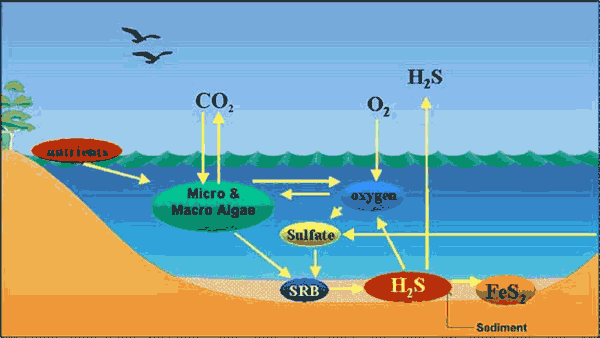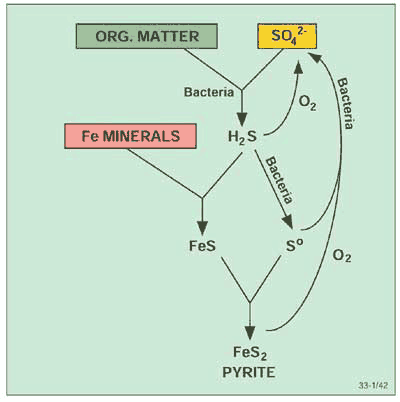Sulfate reduction, biological
Organic matter decomposition can be a consequence of sulfate reduction in the sediments of coastal waterways (and other aquatic systems) [1]. The process is performed by anerobic sulfate-reducing bacteria. The bacteria require: metabolisable organic matter; an anoxic environment (or microenvironment); and dissolved sulfate. Hydrogen sulfide gas (H2S) and alkalinity are generated in the process (see simplified reaction 1).
(Eq. 1) SO42- + 2(CH2O) = H2S + 2HCO32-
Sulfate reduction is often a dominant process in eutrophic systems, occurring after the oxygen-consuming bacteria have removed dissolved oxygen. If dissolved oxygen is present in the water column, organic matter is preferentially decomposed by oxygen-consuming bacteria.

Figure 1. A conceptual model of sulfate reduction and hydrogen sulfide and iron sulfide production in a coastal lake. SRB – Sulfate reducing bacteria.
The fate of hydrogen sulfide
Some hydrogen sulfide from sulfate reduction can be released to the atmosphere (Figure 1). Hydrogen sulfide can be oxidised to sulfate or sulfur (So), or can react with iron sulfide minerals in the sediment (Figure 1 and 2). Iron monosulphides (FeS) form first, but are readily converted to pyrite (FeS2; Figure 2). The overall reaction is shown in Equation 2 [7].
(Eq. 2) Fe2O3 + 4S2-(mostly from H2S) + 6H+ = 2FeS2 + 3H2O + 2e

Figure 2. Diagram of iron
Consequences of sulfate reduction
- H2S smells like rotten eggs, and can detract from the aesthetic amenity of coastal waterways when it is released to the atmosphere [2,5].
- H2S is toxic to a wide range of aquatic organisms [3];
- H2S can inhibit nitrification [4]. When nitrification is inhibited, coupled nitrification-denitrification is also inhibited.
- Ammonium (NH4+) is released from organic matter during degradation by sulfate reduction (Equation 3) [6]. Ammonium is a bioavailable and is readily taken up by plants.
(Eq. 3) 106(CH2O)16(NH3)(H3PO4) + 53SO42- → 106 CO2 + 16 NH3 + H3PO4 + 106 H2O + 53 S2-
- Iron sulfides (e.g. pyrite), formed during sulfate reduction, are an active component of acid sulfate soils (ASS), and problems with acid production and drainage can arise if the pyrite is oxidised.
- Iron sulfides cannot bind phosphate. Therefore, when iron oxyhydroxides are converted to iron sulfides during sulfate reduction, phosphate can be released to the water column [9].
- Skyring, G.W. 1987. Sulfate Reduction in Coastal Ecosystems. Geomicrobiology Journal 5, 3/4, 295-374.
- Murray, E. 2002. GA nose about smelly lake. AusGEO News 65, 7-9.
- Connell, D.W., and Miller, G.J. 1984. Chemistry and Ecotoxicology of Pollution. John Wiley & Sons, N.Y.
- Joye, S.B. and Hollibaugh, J.T. 1995. Influence of sulfide inhibition of nitrification on nitrogen regeneration in sediments. Science 270, 623-625.
- Murray, E.J. and Heggie, D.T. 2002. Factors influencing extensive sulphate reduction in Lake Wollumboola, and intermittently closed/open lake (ICOLL) on the NSW south coast, Proceedings of the annual conference of the Australian Marine Sciences Association, 10-12 July 2002, Fremantle WA.
- Froelich, P. N., Klinkhammer, G. P., Bender, M. L., Luedtke, N., Heath, G. R., Cullen, D., Dauphin, P., Hammond, D., Hartman, B., and Maynard, V. (1979). Early oxidation of organic matter in pelagic sediments of the eastern equatorial Atlantic; suboxic diagenesis. Geochimica et Cosmochimica Acta Pergamon, Oxford. 43, 1075-1090.
- Berner, R.A. 1971. Principles of Chemical Sedimentology. McGraw Hill, Inc, U.S.A, 192-209
- Berner, R.A. 1983. Sedimentary pyrite formation: An update Geochemica et Cosmochimica Acta 48, 605-615
- Roden, E.E. and Edmonds, J.W. 1997. Phosphate mobilization in iron-rich anaerobic sediments: microbial Fe(iii) oxide reduction versus iron-sulphide formation. Arch. Hydrobiol. 139, 347-378.
Contributors
Emma Murray, Geoscience Australia
Graham Skyring, Skyring Environment Enterprises


